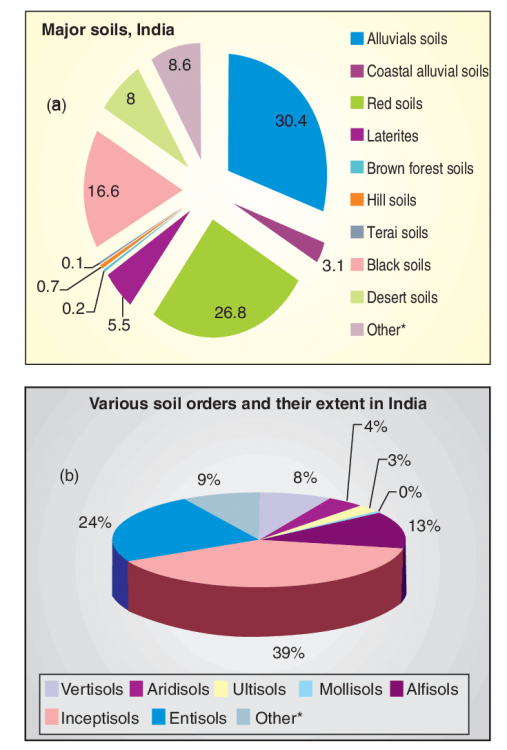Soil is a very precious natural resource for every human being, animals, plants, and other microorganisms. Soil is a mixture of stone particles and organic substances. The particles of soil are evolved on the earth’s surface. Following are the types of soil in India.
Factors that determine soil characteristics
- Parent Material
- Climate
- Environment
- Relief
- Vegetation
- Time
- Other life formations
Major Constituents of the soil
- Air
- Water
- Humus
- Sand
- Mineral particles
A soil boundary is a coating commonly parallel to the soil crust, whose physical factors vary from the layers either in above or in beneath.

Classification of Soils in India
Vasily Dokuchaev was the first person who categorized the soil into different types. As per the Indian Council of Agricultural Research or ICAR in India, the soil has been categorized into 8 types. These kinds of soil are found in different parts of India. They are:
- Alluvial Soil
- Red Soil
- Black Cotton Soil
- Mountainous or Forest Soil
- Desert or Arid Soil
- Saline and Alkaline Soil
- Peaty or Marshy Soil
- Laterite Soil

Now, let’s discuss all the types of soil and its characteristics.
1. Alluvial Soil
- This soil covers more than 43% of the land area of northern plains and river valleys.
- It is mostly found in Delta and estuaries in the part of peninsular-India.
- This soil is more fertile.
- Some of the examples are the Indus-Ganga-Brahmaputra plain, and Narmada-Tapi plain.
- This soil is grey in color.
- This soil contains a high amount of potash and a very low amount of phosphorus.
- This type of soil is transported from one place and deposited by rivers.
- Some of the crops grown in this type of soil are wheat, rice, maize, sugarcane, pulses, oilseed, etc.
Also Read: Characteristics and types of Alluvial Soil
2. Red Soil
- This type of soil is mainly found in low rainfall areas.
- It does not contain lime and kankar.
- It consists of very less amount of lime, phosphate, manganese, nitrogen, humus, and potash.
Its color is red because it consists of ferric oxide.
- The soil is porous in nature.
- Some of the crops grown in this type of soil are Wheat, cotton, pulses, tobacco, oilseeds, potato, etc
3. Black Cotton soil
- This kind of soil is best for cultivating cotton.
- It is found in the Deccan part.
- It has a high water-retaining capacity.
- This kind of soil expands when it is wet and contracts when it dries.
- This soil contains a high amount of Iron, lime, calcium, potassium, aluminum, and magnesium, and a low amount of nitrogen, phosphorus, and organic substances.
- Its color is deep black.
- The texture is clayey.
4. Mountainous Soil or Forest Soil
- These soils have limited improved soil profiles.
- These soils are mainly found in the valleys and hill slopes of the Himalayas.
- These soils are dark brown in color.
- This soil has a very low content of humus and it is acidic in nature.
- Some of the crops grown in this type of soil are orchards, fodder, and legumes.
5. Desert or Arid Soil
- It is basically found under Arid and Semi-Arid areas.
- This soil is deposited mostly by wind activities.
- It contains a high amount of salt.
- This kind of soil lacks moisture and Humus.
- The texture is sandy.
- It is brown in color.
- Nitrogen is inadequate and Phosphate is common.
6. Saline and Alkaline Soils
- This kind of soil is mainly found in Rajasthan, Haryana, Punjab, Uttar Pradesh, Bihar, and Maharashtra.
- It contains sodium chloride and sodium sulfate
- Leguminous crops are basically grown in this kind of soil.
7. Peaty or marshy soil
- It is basically found in areas of heavy rainfall and high humidity.
- The growth of greenery is very less.
- It consists of a huge amount of dead organic matter or humus which makes the soil alkaline.
- It is black in color.
8. Laterite soil
- The word is derived from the Latin word ‘Later’ which represents Brick.
- It becomes soft when it is wet and hard when it is dry.
- This soil is basically found in the areas of high temperature and heavy rainfall.
- Humus content is very low in this kind of soil.
- This soil contains a high amount of Iron and Aluminum and a low amount of Nitrogen, Potash, Potassium, Lime, and Humus.
- It is red in color.
- Some of the crops grown in this type of soil are rice, ragi, sugarcane, and cashew nuts.
Types of Soil in India Map
Here is the MAP, here you can track different types of soil in India Map

Conclusion
We discussed all the types of soil in India with their characteristics and where you will find these kinds of soil in India map.
Also Read: A complete information about sand
Frequently Asked Questions
What are the different types of soil found in India?
There are six major type of soil found in india:
Black Soils
➊ Red Soils
➋ Desert Soils
➌ Laterite Soils
➍ Mountain Soils
➎ Alluvial Soils
Major classification of Indian soils
➊ Alluvial soil
➋ Forest soil
➌ Sub-mountain soil
➍ Snowfields
➎ Red soil
➏ Black Soil
➐ Laterite soil
➑ Saline soil
➒ Peaty soil
How much percentage of alluvial soil in india
Mostly available soil in India (about 43%) which covers an area of 143 sq km.


Leave a comment